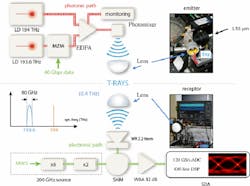Optical-to-Electrical Terahertz Link Enables SISO Communication
Many photonic, terahertz, and RF solutions have been proposed to solve the accelerating bandwidth demand of mobile-communications technologies. For example, optical wireless communications (OWC) using near infrared (NIR) technology can support the necessary data rates. Yet fog effects and dust scattering can cause significant fading effects. Using a hybrid photonic-to-electronic terahertz communications link, a 46-Gb/s data channel has been implemented at 400 GHz by the following researchers from the Institute of Electronics, Micro Electronics, and Nanotechnology and Lille 1 University of France: Guillaume Ducournau; Pascal Szriftgiser; Alexandre Beck; Denis Bacquet; Fabio Pavanello; Emilien Peytavit; Mohammed Zaknoune; Tahsin Akalin; and Jean-Francois Lampin.
The system is composed of two lasers at 193.6 and 194 THz, which are modulated by a Mach-Zehnder optical modulator. The photonic signal is then passed through an optical amplifier and a photomixer. That photomixer emits a 400-GHz carrier with a maximum 92 GHz of bandwidth.
Transmission and reception terahertz polymer lenses are used to create the terahertz point-to-point link. A WR 2.2 conical-horn receiver feeds the received signal to a subharmonic mixer. That signal is then amplified and sent to a 120-GSample/s analog-to-digital converter (ADC) inside a 45-GHz real-time serial data analyzer. A coherent eye diagram was achieved at 46 Gb/s, although higher rates may be achievable if the bit error rate is not limited by the broadband noise generated by the amplifier. See “Ultrawide-Bandwidth Single-Channel 0.4-THz Wireless Link Combining Broadband Quasi-Optic Photomixer and Coherent Detection,” IEEE Transactions on Terahertz Science and Technology, May 2014, p. 328.
About the Author
Jean-Jacques DeLisle
Jean-Jacques graduated from the Rochester Institute of Technology, where he completed his Master of Science in Electrical Engineering. In his studies, Jean-Jacques focused on Control Systems Design, Mixed-Signal IC Design, and RF Design. His research focus was in smart-sensor platform design for RF connector applications for the telecommunications industry. During his research, Jean-Jacques developed a passion for the field of RF/microwaves and expanded his knowledge by doing R&D for the telecommunications industry.

